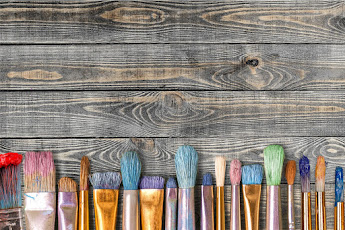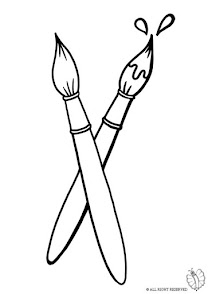acrylic Brushes
All about brushes

Of all the things you spend money on in the studio, let brushes be at the top of the list. This is a quick overview from an acrylic painter's perspective.
Buy good brushes for the important stuff and cheap brushes for the rest.
What does that mean? If you really need to get a good line over two feet of canvas, a cheap brush will not do the job. However, if all you need to do is slather soupy paint all over the background, any old brush will do.
- Take good care of your brushes and they will last a long, long time.
- Never leave your brushes standing in water or thinner.
- After washing your brushes, lay them flat on a paper towel or cloth to dry. This will prevent water from getting into the ferrule and loosening the glue that holds the bristles.
A brush has three main components; the handle, the ferrule and the bristles.
Watercolor brushes have short handles - apparently so the artist won't poke themselves in the eye because they tend to work closer to the paper than artists painting at an easel.
Easel brushes are so named because they have longer handles and are useful when working at an easel, giving the artist the option to work at arm's length.
Brush Shapes
There are many types of brushes, both in shape and type of hair or fiber used to create them. The four main shapes that I use the most are:
round
filbert
bright
Although the last time I checked there are at least eleven different shapes of brushes. Check out the chart(here).
Each shape has a particular use. Rounds are good for curvilinear lines, filigree types of marks and flourishes. Flats are useful for long straight lines. A good flat brush can be loaded with paint and make a very long straight line, depending on how big the brush is. Brights are great for short, choppy paint strokes like you might see on an Impressionist painting. Filberts make rounded paint strokes and are very useful for filling in rounded shapes.
Brush Sizes
Imagine shopping for shoes and the manufacturer just randomly uses any old size they like.
About the only thing you can count on, is that a larger numbered brush (8) will be bigger
If you're an acrylic painter, take care not to let the paint dry on the brushes. That's deadly.
You can bring them back with some really strong cleaners, but the brushes will never be the
same. This is actually the hand soap that Masters makes but I like to hold the soap in my
hand and then rub the brush on the soap to get it clean. This gets my brush clean and my
hand at the same time. And the brush never touches my skin.
Do me a big favor. Never, ever, ever, wash your brush in the palm of your hand.
Why? Because you are grinding the paint right into your skin. Not a good idea.
Although this is not a complete look at brushes by any means, this overview will get you
started.
Send me your questions and comments and I'll be glad to answer them.




Comments
Post a Comment